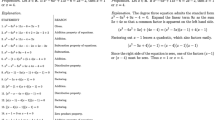Abstract
Baker (2005) claims to provide an example of mathematical explanation of an empirical phenomenon which leads to ontological commitment to mathematical objects. This is meant to show that the positing of mathematical entities is necessary for satisfactory scientific explanations and thus that the application of mathematics to science can be used, at least in some cases, to support mathematical realism. In this paper I show that the example of explanation Baker considers can actually be given without postulating mathematical objects and thus cannot be used by the mathematical realist. I also show that, despite this, mathematics keeps playing an important methodological role in the explanation and does not reduce to a merely computational or descriptive framework.

Similar content being viewed by others
Notes
This possibility for the realist to pursue this strategy is already outlined in Field (1989, p. 14–20).
That explanatory power warrants ontological commitment is assumed by Baker for the sake of argument. I intend to show in the next sections that this is not the case.
In what follows, lcm and gcd are, respectively, the least common multiple and greatest common divisor of X, Y.
A justification for the choice of bounds can be found in Goles et al. (2001, p. 35).
Goles et al. assume that a mutant predator will supersede an existing predator only if it is fitter.
According to Baker ‘[…] number theory deals with intrinsic mathematical properties of the natural number’ (Baker 2005, p. 236), so the use of number-theoretical facts within an explanation involves references to the natural numbers as abstract mathematical entities.
This amounts to saying that the explanandum is satisfied by mathematical objects. For details, see Bangu (2008, p. 18).
However it is not conceded that the mathematical references in the explanandum should be interpreted realistically. The explanandum refers to a property of the length of Magicicada’s life-cycles measured in years, not to a purely number-theoretical property. It will be seen below that this property can in fact be formulated non-numerically and represented numerically by primeness.
‘I do not see how one can coherently deny that mathematical objects play a part in the explanation’ (Baker 2005, p. 234).
Note that one could dismiss a geometrical language and describe congruence, divisibility and juxtaposition as empirical relations between time-intervals.
A ‘meaningful’ use of numbers is one that can be explicitly related to some appropriate empirical content. Meaningfulness is required if numerical results are to be applied to investigate the structure of empirical phenomena. I am not assuming that meaningfulness is only established by proving a representation theorem, although this is what happens in my discussion of the Magicicada case.
The relation D can be seen as an ordering of intervals whose endpoints are in A.
For a proof, see Suppes (1972, pp. 56–58).
This operation is not supposed to correspond to arithmetical multiplication in a numerical structure like N, isomorphic to the given non-numerical structure.
The bounds on life-cycles and their lengths are then expressed using the endpoints of the relevant intervals.
Otherwise gcd(jY, Y) would decrease if Y changed to Y–1, in which case the prey, whose life-cycle is Y–1, would be fitter than the prey with life-cycle Y. But if Y is prime, Y–1 is an even number, so primality is no longer related to fitness maximization.
References
Baker, A. (2005). Are there genuine mathematical explanations of physical phenomena? Mind, 114, 223–237.
Baker, A. (2009). Mathematical explanation in science. The British Journal for the Philosophy of Science, 60, 611–633
Balaguer, M. (1996). Towards a nominalization of quantum mechanics. Mind, 105, 209–226
Balaguer, M. (1998). Platonism and ant-Platonism in the philosophy of mathematics. New York: Oxford University Press.
Bangu, S. (2008). Inference to the best explanation and mathematical realism. Synthese, 160, 13–20.
Burgess, J. (1985). Synthetic mechanics. Journal of Philosophical Logic, 13, p. 379–395.
Burgess, J. P. (1991). Synthetic mechanics revisited. Journal of Philosophical Logic, 20, 121–130.
Burgess, J. P. (1992). Synthetic physics and nominalist realism. In P. Ehrlich & W. C. Savage (Eds.), Philosophical and foundational issues in measurement theory (pp. 119–138). London: Lawrence Erlbaum Associates.
Colyvan, M. (2001). The indispensability of mathematics. Oxford: Oxford University Press.
Field, H. (1980). Science without numbers. Oxford: Blackwell.
Field, H. (1984). Can we dispense with space-time? (In P. Asquith, P. & P. Kitcher (Eds.) PSA 1984: Proceedings of the 1985 Biennial Meetings of the Philosophy of Science Association, Vol 2: Symposia and Invited Papers (pp. 33–90). Chicago: The University of Chicago Press).
Field, H. (1989). Realism, mathematics and modality. Oxford: Blackwell.
Goles, E., Schulz, O., & Markus, M. (2001). Prime number selection of cycles in a predator-prey model. Complexity, 6, 33–38.
Lyon, A., & Colyvan, M. (2008). The explanatory power of phase spaces. Philosophia Mathematica, 16, 227–243.
Malament, D. (1985). Review of Science without numbers: A defense of nominalism by Hartry H. Field. The Journal of Philosophy, 79, 523–534.
Melia, J. (2000). Weaseling away the indispensability argument. Mind, 109, 455–480.
Melia, J. (2002). Response to Colyvan. Mind, 111, 75–79.
Putnam, H. (1971). Philosophy of logic. (In H. Putnam, Mathematics, matter and method (pp. 323–357) Cambridge: Cambridge University Press).
Quine, W. V. O. (1981). Theories and things. Cambridge MA: Harvard University Press.
Resnik, M. D. (1995). Scientific vs mathematical realism: The indispensability argument. Philosophia Mathematica, 3, 166–174.
Resnik, M. D. (1997). Mathematics as a science of patterns. Oxford: Clarendon Press.
Suppes, P. (1972). Finite equal-interval measurement structures. Theoria, 38, 45–63.
Yoshimura, J. (1997). The evolutionary origins of periodical cicadas during ice ages. American Naturalist, 149, 112–124.
Acknowledgments
I wish to thank Alan Baker, Sorin Bangu, Mary Leng and David Liggins for helpful comments on previous drafts of this paper. Its clarity and structure have also benefited from valuable suggestions and remarks from two anonymous referees.
Author information
Authors and Affiliations
Corresponding author
Rights and permissions
About this article
Cite this article
Rizza, D. Magicicada, Mathematical Explanation and Mathematical Realism. Erkenn 74, 101–114 (2011). https://doi.org/10.1007/s10670-010-9261-z
Received:
Accepted:
Published:
Issue Date:
DOI: https://doi.org/10.1007/s10670-010-9261-z




